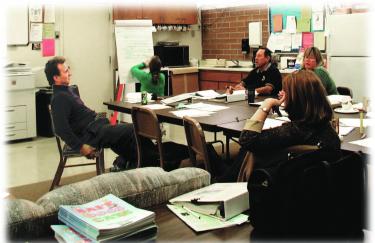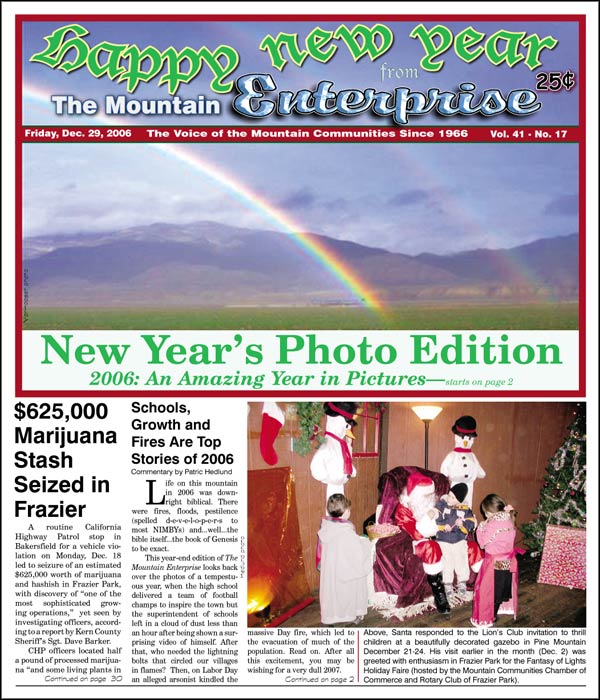Commentary by Patric Hedlund
Life on this mountain in 2006 was downright biblical. There were fires, floods, pestilence (spelled d-e-v-e-l-o-p-e-r-s to most NIMBYs) and…well…the bible itself…the book of Genesis to be exact.
This year-end edition of The Mountain Enterprise looks back over the photos of a tempestuous year, when the high school delivered a team of football champs to inspire the town but the superintendent of schools left in a cloud of dust less than an hour after being shown a surprising video of himself. After that, who needed the lightning bolts that circled our villages in flames? Then, on Labor Day an alleged arsonist kindled the massive Day fire, which led to the evacuation of much of the population. Read on. After all this excitement, you may be wishing for a very dull 2007.
Fewer total students attend the four schools that collectively comprise El Tejon Unified School District than the number enrolled in just one of the smaller high schools in Los Angeles. Numbers fluctuate as families move in and out of this mountain district, but only about 1300 children, from kindergarteners to high school seniors, are served by ETUSD. Even so, the school district is the single largest employer on the mountain.
And, if you believe the studies by the Gates Foundation about the optimal size for learning communities, this district is a jewel, sparkling with opportunities—if managed well—for students in our small academic settings to receive the kind of personal attention of which big city schools can only dream. This is the kind of place where education and community involvement can flourish.
In late 2005, local voters agreed for the first time in 35 years to tax themselves to replace aging temporary structures with new permanent classrooms. Superintendent John Wight had promised voters generous state matching funds for this building project, as did president of the board, Steve Newman.
Then, in a special meeting on Sunday, January 1, 2006 (just weeks after educators nationwide had been rocked by a federal court ruling warning public schools against teaching biblical creationism as a scientific explanation for the origins of life), the ETUSD board of governors made a decision that hurled them into the international media spotlight and would ultimately derail their building project.
With the urging of Superintendent Wight and the support of Frazier Mountain High School Principal Dan Penner, trustees voted to authorize “Philosophy of Intelligent Design” as a six-week FMHS intersession course, to be taught by a soccer coach.
The syllabus originally shown to the board was based on 23 videos, mostly by creationist producers. To indicate balance, the syllabus proposed that students would hear from two "evolutionists." One of them had been dead for two years , the other (Jet Propulsion Laboratory geologist, local parent and founder of the school’s successful robotics club, Ken Hurst) had already refused to participate, hand-delivering a thorough letter analyzing the problems with the course. The science and math faculty of FHMS had also protested against the class- although the trustees were give none of these facts by the superintendent, the instructor or principal.
The Mountain Enterprise reported the omissions, and the first firestorm of the new year ensued. On New Years Day a revised syllabus for the class was presented. Three trustees (Steve Newman, Stacey Gustafson and Paula Regan) voted to allow the class. Two voted in opposition. The class began.
After a lawsuit was filed by 11 parents with the participation of Americans United for Separation of Church and State (which had won the Dover, Pennsylvania lawsuit just weeks before), the board signed a settlement to stop the course. But then Superintendent Wight stepped forward, maintaining the media spotlight by taking over as instructor of the class himself, “teaching the controversy” by asking students to criticize media coverage of the event. Wight invited out-of-town newspaper and television reporters into the class, but barred coverage by The Mountain Enterprise. When Enterprise reporters, adhering to federal and state law, went to the school to report, Wight had FMHS principal Dan Penner call the sheriff in an attempt to arrest Managing Publisher Gary Meyer (above) and Managing Editor Patric Hedlund (who took this photo in front of the high school as the two were ejected from the library). The two had reported over 150 times in the past without incident from that same room.
Meanwhile, preparations for re-building the district’s classrooms languished. Wight refused to answer reporters’ questions about the status of state matching funds and failed to secure community input into building plans that would fundamentally change the district’s campuses.
It appeared to many observers that he rushed trustees into contracts with specific companies. Questions from concerned parents such as Anita Anderson were greeted with rebukes.
On the thirty-first of May a special meeting was hastily called at the district office. There, it was revealed that Wight had suddenly resigned and had left the district immediately. At the time no explanation was given by the board.
But there were plenty of rumors. Missing gasoline had plagued the district since Wight had taken the job. A concerned employee had activated a surveillance camera.
The Mountain Enterprise filed a public records request. This newspaper had also secured documents regarding Wight’s troubled exits from four prior school districts, including litigation problems and numerous complaints from parents and school employees. But no prior school board had warned ETUSD about these problems before Wight’s hiring in 2004.
In short order the video tape was released to the public and a private investigator’s report revealed numerous questions about the building contracts signed by the board.
The bad news continued. It was learned that the “dollar for dollar” promises of state matching funds for the bond had never been possible. Thirty cents to the dollar is optimistic. The “relocatables” selected by Wight and the board failed to comply with the state’s definition of “permanent classrooms.”
Taxpayers learned that their money will be able to purchase less than half of what they had been led to believe would be covered by their "yes" votes.
The good news? It can only be up up from here. Happy New Year.
This is part of the December 29, 2006 online edition of The Mountain Enterprise.
Have an opinion on this matter? We'd like to hear from you.



